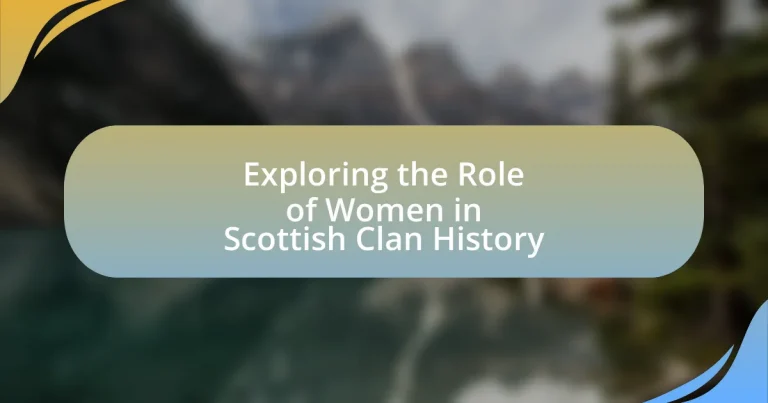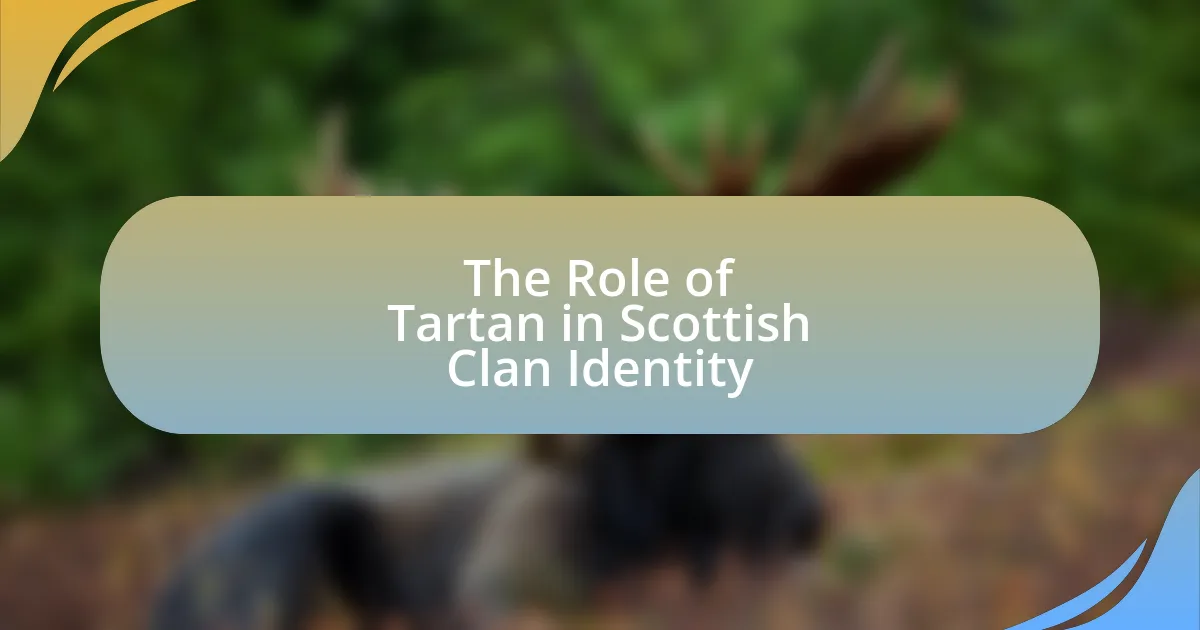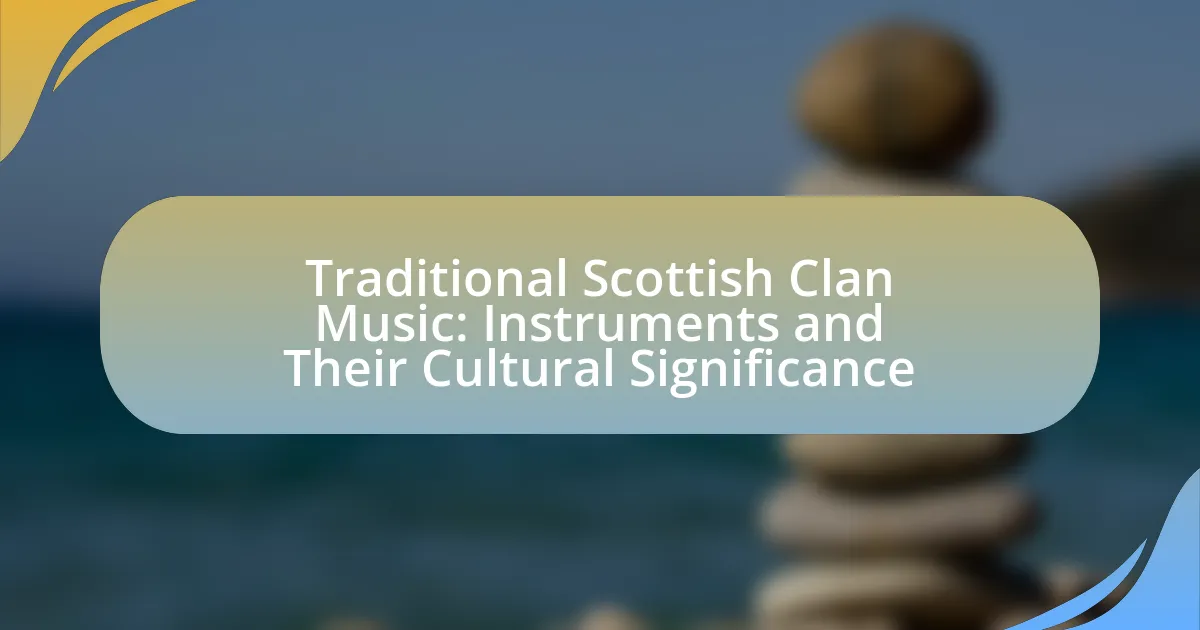The article explores the significant role of women in Scottish clan history, highlighting their contributions to clan identity, leadership, and cultural practices. Women managed households, influenced political alliances through marriage, and participated actively in clan governance, often stepping into leadership roles during conflicts. Notable figures such as Flora MacDonald and Lady Margaret Stewart exemplify the power and influence women wielded within their clans. The article also examines how women’s involvement shaped social structures, preserved traditions, and left lasting cultural legacies in Scottish heritage.
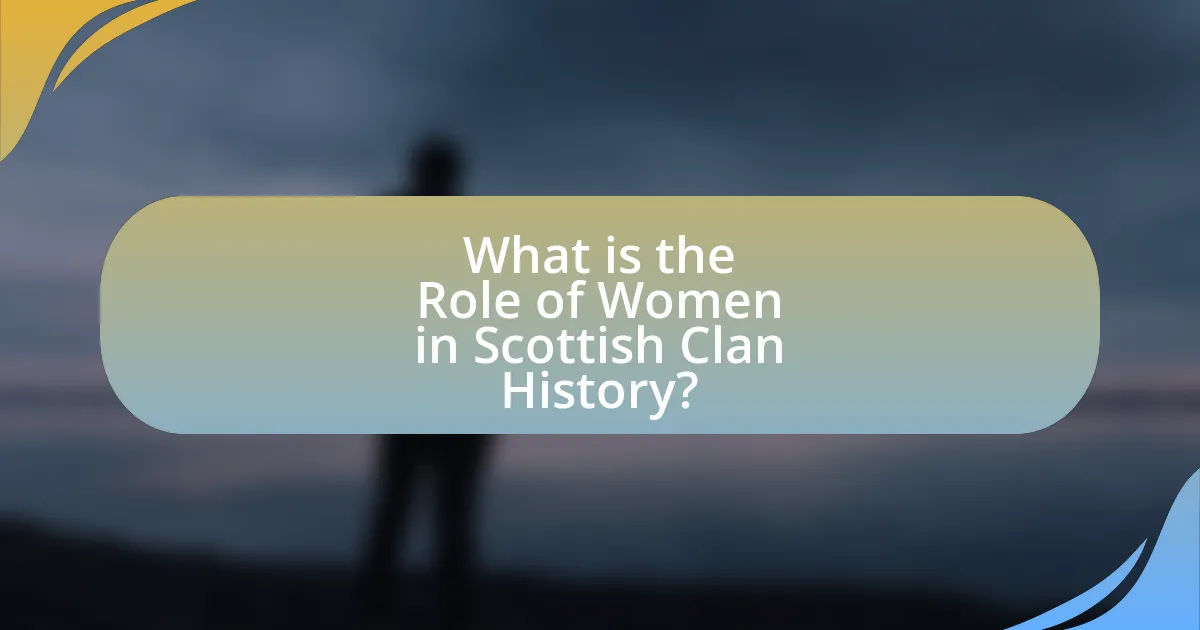
What is the Role of Women in Scottish Clan History?
Women played a significant role in Scottish clan history, often serving as key figures in maintaining clan identity and heritage. They were responsible for managing households, which included overseeing the clan’s resources and ensuring the well-being of its members. Additionally, women often held positions of influence, such as clan leaders or advisors, particularly during times of conflict or succession crises. Historical records indicate that women like Lady Margaret Stewart and Lady Anne Gordon wielded considerable power and influence within their clans, demonstrating their integral role in clan politics and social structure.
How have women influenced Scottish clans throughout history?
Women have significantly influenced Scottish clans throughout history by serving as key figures in lineage, diplomacy, and clan leadership. Historically, women were often the bearers of clan identity, as they played crucial roles in marriage alliances that strengthened ties between clans, such as the marriage of Margaret Stewart to the MacDonald clan, which helped secure peace and cooperation. Additionally, women like the famous clan leader Flora MacDonald actively participated in political and military affairs, notably aiding Bonnie Prince Charlie during the Jacobite uprising. Their involvement in clan governance and social structures often ensured the continuity and stability of clan traditions and heritage, demonstrating their integral role in the survival and evolution of Scottish clans.
What specific roles did women play in clan leadership?
Women in Scottish clan leadership often held significant roles, including acting as clan chiefs, managing clan affairs, and influencing succession. Historical records indicate that women could inherit leadership positions, particularly in the absence of male heirs, as seen in the case of Lady Margaret MacDonald, who led her clan in the 16th century. Additionally, women served as key advisors and negotiators in alliances and conflicts, demonstrating their integral role in maintaining clan stability and power dynamics. Their contributions were essential in shaping clan identity and governance, highlighting the importance of women’s involvement in Scottish clan history.
How did women’s contributions shape clan identity and culture?
Women’s contributions significantly shaped clan identity and culture by serving as custodians of traditions, mediators in alliances, and key figures in social structures. Women often managed household affairs, preserving clan heritage through storytelling, rituals, and the transmission of cultural practices. For instance, women played crucial roles in arranging marriages that strengthened clan ties, thereby influencing political alliances and social cohesion. Historical records indicate that women like the Clan MacDonald matriarchs were pivotal in maintaining clan loyalty and identity during turbulent times, showcasing their integral role in the clan’s survival and cultural continuity.
What historical events highlight the significance of women in Scottish clans?
Historical events that highlight the significance of women in Scottish clans include the role of women during the Jacobite risings, particularly in the 18th century. Women such as Flora MacDonald played crucial roles by aiding the escape of Bonnie Prince Charlie after the Battle of Culloden in 1746, demonstrating their influence in clan loyalty and political affairs. Additionally, clan matriarchs often managed estates and maintained clan unity during times of conflict, as seen in the leadership of women like Lady Anne Gordon, who was instrumental in supporting her clan during the Jacobite uprisings. These events underscore the vital contributions of women in maintaining clan identity and influence in Scottish history.
Which notable women are recognized in Scottish clan history?
Notable women recognized in Scottish clan history include Mary, Queen of Scots, who played a significant role in the political landscape of Scotland during the 16th century, and Flora MacDonald, known for her bravery in aiding Bonnie Prince Charlie during his escape after the Jacobite defeat in 1746. Mary, Queen of Scots, was a central figure in the tumultuous period of Scottish history, influencing clan loyalties and political alliances. Flora MacDonald’s actions exemplified the courage and loyalty of women in clan narratives, as she risked her life to protect a royal figure. These women are celebrated for their contributions and impact on Scottish heritage and clan dynamics.
How did women respond to challenges during clan conflicts?
Women responded to challenges during clan conflicts by actively participating in various roles that supported their clans. They often took on responsibilities such as managing household affairs, providing logistical support, and sometimes even engaging in direct conflict. Historical accounts indicate that women like Lady Margaret Campbell of Glenorchy played crucial roles in negotiating peace and maintaining clan alliances during turbulent times. Additionally, women were known to rally support, care for the wounded, and ensure the continuity of clan traditions and leadership, demonstrating their resilience and strategic importance in clan dynamics.
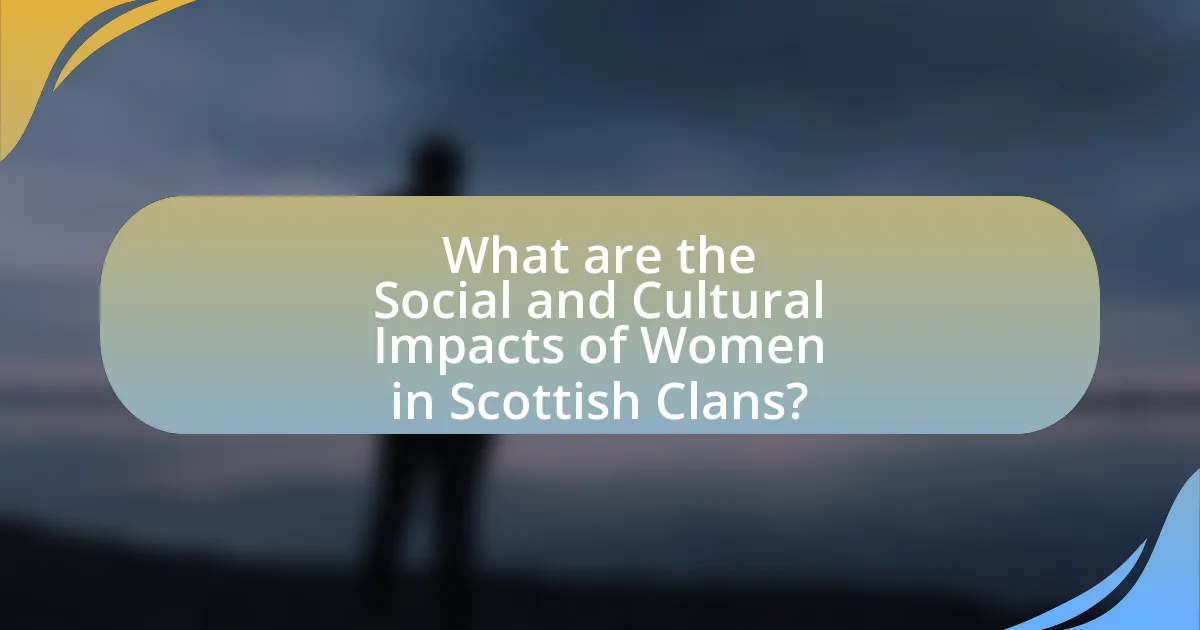
What are the Social and Cultural Impacts of Women in Scottish Clans?
Women in Scottish clans significantly influenced social structures and cultural practices, serving as key figures in maintaining clan identity and cohesion. Their roles included managing households, preserving traditions, and often acting as mediators in clan disputes, which reinforced social stability. Historically, women were also involved in the economy through textile production and agricultural work, contributing to the clan’s wealth and sustainability. For instance, women played a crucial role in the production of tartan and other textiles, which became symbols of clan identity. Additionally, women often held positions of power, such as clan matriarchs, influencing decisions and alliances that shaped clan dynamics. This multifaceted involvement underscores the essential contributions of women to the social and cultural fabric of Scottish clans.
How did women contribute to the social structure of clans?
Women contributed significantly to the social structure of clans by serving as key figures in lineage, inheritance, and social cohesion. In many Scottish clans, women were responsible for passing down family names and property, which reinforced clan identity and continuity. Additionally, women often played vital roles in maintaining alliances through marriage, thereby strengthening ties between clans. Historical records indicate that women could hold positions of influence, such as clan matriarchs, who guided decisions and upheld traditions, further solidifying their integral role in the clan’s social framework.
What roles did women have in clan gatherings and ceremonies?
Women played significant roles in clan gatherings and ceremonies, often serving as key participants in rituals and decision-making processes. In many Scottish clans, women were responsible for organizing events, preparing food, and ensuring the well-being of guests, which underscored their importance in maintaining clan cohesion. Additionally, women often participated in ceremonial roles, such as performing traditional songs and dances, which were integral to the cultural identity of the clan. Historical records indicate that women could also influence clan leadership decisions, particularly in the absence of male leaders, highlighting their vital contributions to clan dynamics and heritage.
How did women’s roles evolve over different historical periods?
Women’s roles in Scottish clan history evolved significantly from the medieval period through the early modern era. Initially, women held vital positions within clans, often managing households and participating in agricultural activities, which were essential for clan survival. During the medieval period, women could inherit land and titles, as seen in the case of clan leaders like the Countess of Ross, who wielded considerable power.
As society transitioned into the early modern period, women’s roles began to shift due to changing economic and social structures. The rise of the patriarchal system limited women’s rights, confining them primarily to domestic spheres. However, women still played crucial roles in clan alliances through marriage, which was often used to secure political power and resources.
By the 18th century, the Enlightenment and subsequent social changes began to challenge traditional gender roles. Women became more involved in cultural and educational pursuits, contributing to the preservation of clan histories and traditions. The Jacobite uprisings also saw women actively participating in political movements, further demonstrating their evolving roles.
Overall, the evolution of women’s roles in Scottish clan history reflects broader societal changes, with women transitioning from influential figures in clan governance to more restricted domestic roles, and eventually re-emerging as active participants in cultural and political spheres.
What cultural legacies have women left in Scottish clan traditions?
Women have left significant cultural legacies in Scottish clan traditions, particularly through their roles in family lineage, clan leadership, and the preservation of cultural practices. Historically, women were often the bearers of clan identity, as they passed down surnames and maintained family connections, which were crucial for clan cohesion. Additionally, women played vital roles in clan governance, with some serving as leaders or influential figures in decision-making processes, exemplified by figures like Flora MacDonald, who aided in the Jacobite cause. Furthermore, women contributed to the preservation of Scottish culture through traditional crafts, music, and storytelling, ensuring the transmission of cultural heritage across generations. These contributions underscore the integral role women have played in shaping and sustaining Scottish clan traditions.
How are women’s stories preserved in Scottish folklore?
Women’s stories are preserved in Scottish folklore primarily through oral traditions, ballads, and storytelling practices that have been passed down through generations. These narratives often highlight women’s roles in clan history, their contributions to community life, and their experiences during significant historical events. For instance, tales of figures like the legendary warrior woman, Gráinne Mhaol, illustrate the strength and agency of women in Scottish history. Additionally, collections such as “The Scottish Ballad” by Francis James Child document these stories, ensuring their survival and continued relevance in cultural memory.
What impact did women have on clan music and arts?
Women significantly influenced clan music and arts by serving as primary transmitters of cultural traditions and practices. Their roles included composing songs, performing in gatherings, and crafting instruments, which helped preserve and evolve the musical heritage of their clans. Historical records indicate that women often participated in social events where music was central, thus shaping the repertoire and styles that defined clan identity. Additionally, women’s contributions to visual arts, such as weaving and embroidery, complemented musical expressions, creating a holistic cultural experience within clans.

How Can We Further Explore the Role of Women in Scottish Clan History?
To further explore the role of women in Scottish clan history, researchers can analyze historical records, clan documents, and oral histories that specifically mention women’s contributions and influence within clans. For instance, examining primary sources such as clan charters, letters, and legal documents can reveal women’s roles in land ownership, inheritance, and decision-making processes. Additionally, studies like “Women and the Scottish Clan System” by Dr. Fiona Watson highlight the significant impact women had on clan dynamics, including their roles as leaders and negotiators during conflicts. By focusing on these specific historical contexts and utilizing interdisciplinary approaches, such as gender studies and anthropology, a more comprehensive understanding of women’s roles in Scottish clan history can be achieved.
What resources are available for studying women’s roles in Scottish clans?
Resources available for studying women’s roles in Scottish clans include historical texts, academic journals, and specialized books. Notable historical texts such as “The Clan and the Scottish Highlands” by John Prebble provide insights into clan dynamics, including women’s contributions. Academic journals like “Scottish Historical Review” often publish articles focused on gender studies within Scottish history, offering peer-reviewed research on women’s roles. Additionally, books such as “Women and the Scottish Highlands” by Elizabeth Ewan explore the specific experiences and influences of women in clan society. These resources collectively contribute to a deeper understanding of the significant yet often overlooked roles women played in Scottish clans.
Which books and articles provide insights into this topic?
Books and articles that provide insights into the role of women in Scottish clan history include “The Women of Scotland: A History” by Elizabeth Ewan, which explores women’s contributions to Scottish society and clan dynamics. Another significant work is “Clans and Families of Ireland and Scotland” by Peter Berresford Ellis, which discusses the influence of women within clan structures. Additionally, the article “Women and the Scottish Clans” by Fiona Watson, published in the Scottish Historical Review, examines the historical roles and impacts of women in clan life. These sources collectively highlight the multifaceted roles women played in shaping clan history and culture in Scotland.
How can historical sites enhance our understanding of women’s contributions?
Historical sites can enhance our understanding of women’s contributions by providing tangible evidence of their roles and influence within historical contexts. For instance, sites like castles and clan homes often contain artifacts, documents, and narratives that highlight women’s involvement in governance, social structures, and cultural practices. Research indicates that women in Scottish clans played crucial roles in maintaining lineage and managing estates, as seen in the records of clan leaders’ wives who wielded significant power. These historical sites serve as physical reminders of women’s agency, allowing for a more nuanced appreciation of their contributions to Scottish clan history.
What are some practical ways to engage with this aspect of Scottish history?
To engage with the role of women in Scottish clan history, individuals can participate in local historical societies that focus on Scottish heritage, which often host events and discussions centered on women’s contributions. Additionally, visiting museums such as the National Museum of Scotland, which features exhibits on clan history, provides insights into the lives of women in these clans. Reading scholarly works, such as “Women and the Scottish Diaspora” by Marjory Harper, offers a deeper understanding of women’s roles in clan dynamics. Attending lectures or workshops on Scottish history can also enhance knowledge and appreciation of women’s impact within clans.
